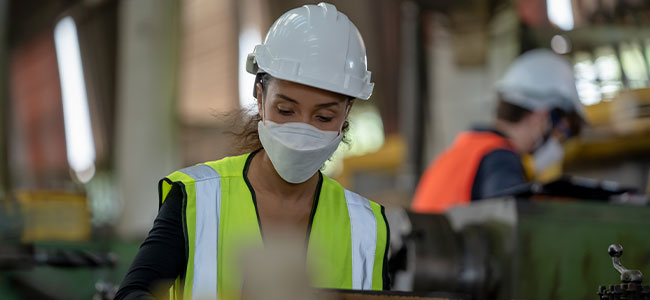
Pandemic-Proofing Our Air: How Standard 241 Makes Indoor Air Safer
How a game-changing health standard strengthens protection against airborne viruses. ASHRAE’s recently released Standard 241 serves as a helpful reference for minimum safety standards in various buildings and spaces.
- By M. Elaine Dasti, Tom Burgess
- May 01, 2024
In the early days of the pandemic, a patient at a local physical therapy clinic noted the impressive measures taken to ensure infection control and how it made her more comfortable. Physical therapy involves a lot of close contact, and given the effects of the pandemic, the office was doing its best to make patients feel comfortable. They put up signs explaining the enhanced filtration in their HVAC system; there were UV disinfection lights by the ceiling and other air and surface disinfection practices.
The physical therapy group was not alone in trying to protect their staff and customers during the pandemic. In their case, they tried a combination of technologies, hoping it would work and make people feel safer. However, the pandemic illustrated the need for standards to be implemented to ensure that proper equipment has been tested and is ultimately effective. Without safety and health measures, employees and clients are subject to unsafe and unhealthy environments that can endanger them. Standards for infection control equipment provide protection against public health issues such as the COVID-19 pandemic.
A New Standard Arises
The COVID-19 crisis revealed that health and safety measures put in place to fight against airborne viruses were not up to the challenge of a pandemic. Guidance on how to keep employees and clients safe in the face of the crisis was continually evolving as we learned more about the virus and its controls. Sales of equipment like air purifiers and disinfection methods grew substantially and were often used with hope more than data on effectiveness.
For companies such as T&M Associates working to mitigate infection risks through new programs or technology, we were often met with limited available data. A new standard was necessary, and on March 31, 2020, ASHRAE, a professional association otherwise known as the American Society of Heating, Refrigerating, and Air-Conditioning Engineers, formed its Epidemic Task Force (ETF). After realizing just how ill-prepared the industry was in mitigating COVID-19 and other airborne virus transmissions, ASHRAE began working on standard measures and solutions.
In July 2023, ASHRAE released Standard 241, Control of Infectious Aerosols, providing specific directions on controls for airborne viruses. Though the Standard is not a regulatory requirement, it serves as an industry reference to be adopted for minimum safety standards around indoor air quality in various buildings and spaces (e.g., schools, hospitals, residential homes), separate from laboratories and health facilities.
Given the previous lack of standards for such spaces, Standard 241 provides only minimum measures; future updates are expected as the industry evolves. But the importance of having a minimum standard that we, our manufacturers, and employees can look to will help mitigate the risk of viral transmission in any given space. Standard 241 was created to ensure that the systems that provide the air we breathe at work or where we live can effectively reduce the risk of airborne disease while considering factors such as energy usage and fresh air supply. The Standard has set requirements for air-cleaning systems, filtration systems, building operations, maintenance, building renovations, and pre-building equipment. We encourage industry colleagues to read the Standard, but below are key takeaways:
Testing Procedures
Standard 241 requires a third-party independent testing laboratory to complete all testing of the effectiveness and safety of ventilation and air-cleaning devices. While some procedures will be applied immediately, others will take longer, such as testing for air cleaner effectiveness.
These tests include sampling equipment, filtering particles, using mathematical/scientific calculations, and documentation of testing safety. The laboratory will conduct various tests to ensure safety and health standards are up to Standard and prepare a test report that details such. The manufacturer will then review the final report and certify its effectiveness.
Mathematical and Scientific Calculations
The Standard has created multiple mathematical equations specifically designed to test air quality rates in the face of infection. These calculations detail testing for clean airflow rate, air distribution, chemical reactions, ventilation, and individuals’ breathing capacity versus the size of buildings. Such calculations also serve as guidelines for industry individuals to consider when designing systems for both new construction and renovation projects.
Operations & Maintenance and Building Readiness Plan
Standard 241 provides operations and maintenance standards for industry workers. It details information regarding cleanliness, up-to-date engineering and technical systems, inventory details, and facility supplies. Industry workers must check and replace air-cleaning controls or filters when necessary and ensure the accuracy of air delivery sensors.
The operations and maintenance standards include a Building Readiness Plan, for which a template is available. The Building Readiness Plan or BRP, modeled after one created by the ETF, will be drafted to assess necessary engineering and non-engineering controls of a given building (existing or not), allowing for clean airflow. A physical copy of the BRP must remain onsite and updated annually or during changes to the building’s controls.
Though ASHRAE’s Standard 241 was created out of the havoc of the COVID-19 pandemic, the situation demanded new health and safety measures. Rather than companies guessing whether a technology is effective in mitigating infection, engineers now have set guidelines they can follow detailing specific design instructions that also balance infection control. While the Standard is not a requirement, it is strongly encouraged to be adopted widely by the industry. In the face of other impending health crises, Standard 241 will protect us better from respiratory viruses.
This article originally appeared in the April/May 2024 issue of Occupational Health & Safety.